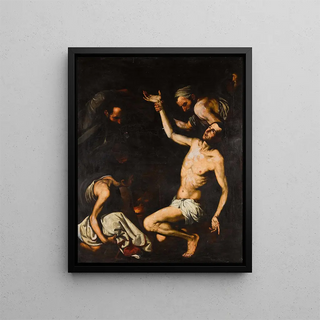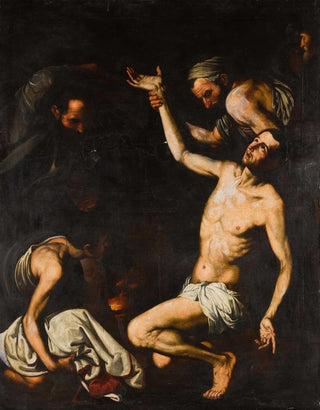Art print The martyrdom of Saint Lawrence - School of Jusepe de Ribera


View from behind

Frame (optional)
In the fascinating world of baroque art, "The Martyrdom of Saint Lawrence" stands out as an iconic work, capturing the very essence of faith and sacrifice. This painting, created by the school of Jusepe de Ribera, evokes a dramatic intensity that transports the viewer to the heart of a scene where pain and spirituality intertwine. Through plays of light and shadow, the artist manages to create an atmosphere that is both poignant and transcendent, inviting each person to contemplate the tragic destiny of the saint, martyred for his faith. The art print of this masterpiece allows for appreciation not only of its striking aesthetics but also of its universal message, resonating even today.
Style and uniqueness of the work
Ribera's style is characterized by an exceptional mastery of chiaroscuro, a technique that gives his compositions a striking depth. In "The Martyrdom of Saint Lawrence," the contrasts between luminous areas and deep shadows accentuate the expression of faces and bodies, making palpable the suffering of the saint. The meticulous details, from the textures of clothing to the expressions of the characters, testify to an attention to physical reality while conveying a spiritual dimension. The color, rich and vibrant, also contributes to the emotional intensity of the work, each hue being carefully chosen to reinforce the drama of the scene. Thus, this painting does not merely depict a historical event; it makes it a sensory and spiritual experience.
The artist and his influence
Jusepe de Ribera, a major figure of Spanish baroque, knew how to mark his era with his unique approach to painting. Originating from Spain, he was influenced by Italian masters, while developing a style that is entirely his own, imbued with a deep sensitivity to the human condition. His ability to capture pain and dignity in human figures made him a pioneer in portrait and religious scene art. Ribera also played a crucial role in the evolution of art in Spain, inspiring many artists to explore similar themes of suffering and faith. The power of

Matte finish

View from behind

Frame (optional)
In the fascinating world of baroque art, "The Martyrdom of Saint Lawrence" stands out as an iconic work, capturing the very essence of faith and sacrifice. This painting, created by the school of Jusepe de Ribera, evokes a dramatic intensity that transports the viewer to the heart of a scene where pain and spirituality intertwine. Through plays of light and shadow, the artist manages to create an atmosphere that is both poignant and transcendent, inviting each person to contemplate the tragic destiny of the saint, martyred for his faith. The art print of this masterpiece allows for appreciation not only of its striking aesthetics but also of its universal message, resonating even today.
Style and uniqueness of the work
Ribera's style is characterized by an exceptional mastery of chiaroscuro, a technique that gives his compositions a striking depth. In "The Martyrdom of Saint Lawrence," the contrasts between luminous areas and deep shadows accentuate the expression of faces and bodies, making palpable the suffering of the saint. The meticulous details, from the textures of clothing to the expressions of the characters, testify to an attention to physical reality while conveying a spiritual dimension. The color, rich and vibrant, also contributes to the emotional intensity of the work, each hue being carefully chosen to reinforce the drama of the scene. Thus, this painting does not merely depict a historical event; it makes it a sensory and spiritual experience.
The artist and his influence
Jusepe de Ribera, a major figure of Spanish baroque, knew how to mark his era with his unique approach to painting. Originating from Spain, he was influenced by Italian masters, while developing a style that is entirely his own, imbued with a deep sensitivity to the human condition. His ability to capture pain and dignity in human figures made him a pioneer in portrait and religious scene art. Ribera also played a crucial role in the evolution of art in Spain, inspiring many artists to explore similar themes of suffering and faith. The power of
12,34 €






